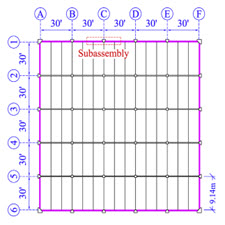توضیحات
ABSTRACT
This paper documents the experimental development of a new spandrel-to-column moment connection detail for progressive collapse resistance in precast concrete building frames. This study focuses on a 10-story prototype precast concrete frame building with perimeter special moment frames (SMF) that are subjected to a groundfloor column removal. The experimental subassembly represents a spandrel-to-column connection on the perimeter SMF ear the middle of the building face (i.e. not at the corners). The connection is non-emulative and utilizes unbonded high-strength steel post-tensioning (PT) bars which pass through ducts in the column and are anchored to the spandrels via bearing plates. The proposed design strives for construction simplicity, avoids field welding and/or grouting, and maximizes ductility by allowing the high strength steel bars to act as structural “fuses” when yielding. A full-scale quasi-static pushdown test is performed on two variants of the proposed connection: one with higher moment-rotation capacity and limited ductility, and another with lower capacity and higher ductility. The results show that the connection can reliably achieve its design yield capacity, performs well under service level demands, and can achieve moderate-to-high ductility. The experimental results are then applied to a system-level computational model of the prototype building frame under a column removal scenario. The results of a nonlinear dynamic analysis demonstrate that the system can arrest progressive collapse in the event of a single column loss scenario when either variant of the proposed connection is considered.
INTRODUCTION
Progressive collapse of a structural system occurs when localized failure of a primary load-bearing element leads to a larger, more widespread collapse of adjoining portions of the structure. This type of collapse, which can affect multiple floors and/or multiple bays up to the entire structure, is regarded as a disproportionate response to the initial local damage. To prevent a chain reaction of structural failure in elements surrounding the local damage, a structural system must be able to redistribute its loads to bridge over the damaged areas without suffering a catastrophic collapse. In current design guidelines, the initial local failure for framed structures is typically identified as the significant loss of load-carrying capacity by a single primary vertical loadbearing element (i.e. a column).
Year: ۲۰۱۹
Publisher : ELSEVIER
By : Spencer E. Quiel, Clay J. Naito, Corey T. Fallon
File Information: English Language/ 15 Page / size: 4.18 MB
سال : ۱۳۹۷
ناشر : ELSEVIER
کاری از : اسپنسر E. Quiel، Clay J. Naito، Corey T. Fallon
اطلاعات فایل : زبان انگلیسی / 15 صفحه / حجم : MB 4.18









نقد و بررسیها
هنوز بررسیای ثبت نشده است.